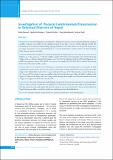Please use this identifier to cite or link to this item:
https://hdl.handle.net/20.500.14356/1039Full metadata record
| DC Field | Value | Language |
|---|---|---|
| dc.contributor.author | Basnyat, Shaila | - |
| dc.contributor.author | Banjara, Megha Raj | - |
| dc.contributor.author | Ghimire, Prakash | - |
| dc.contributor.author | Matlashewski, Greg | - |
| dc.contributor.author | Singh, Anjana | - |
| dc.date.accessioned | 2023-04-20T07:43:49Z | - |
| dc.date.available | 2023-04-20T07:43:49Z | - |
| dc.date.issued | 2022 | - |
| dc.identifier.citation | BasnyatS., BanjaraM. R., GhimireP., MatlashewskiG., & SinghA. (2022). Investigation of Visceral LeishmaniasisTransmission in Selected Districts of Nepal. Journal of Nepal Health Research Council, 20(01), 194-201. https://doi.org/10.33314/jnhrc.v20i01.4161 | en_US |
| dc.identifier.issn | Print ISSN: 1727-5482; Online ISSN: 1999-6217 | - |
| dc.identifier.uri | http://103.69.126.140:8080/handle/20.500.14356/1039 | - |
| dc.description | Original Article | en_US |
| dc.description.abstract | Abstract Background: Visceral leishmaniasis is transmitted to humans by Leishmania donovani infected Phlebotomus argentipes sandflies. Nepal has successfully met the elimination target of less than 1 case per 10,000, although recently this threshold has been surpassed demonstrating ongoing transmission. The main objective of the present study was to investigate transmission of visceral leishmaniasis in 4 visceral leishmaniasis endemic districts of Nepal including Palpa, Morang, Saptari and Sarlahi. Methods: Human blood samples (331), domestic animals blood samples [goats (n =67), dogs (n =1), cows (n = 6), buffaloes (n = 16), and ox (n = 10)] and sandflies samples (3976 from 142 households) were collected from the villages of these 4 districts. Human blood samples were tested for VL antibodies using the rK39 rapid diagnostic test (InBios International, Seattle, WA). kDNA of L.donovani was amplified by PCR from DNA extracted from human blood, animal blood and sandfly samples. Results: Out of 331 screened across 4 districts,32 were positive on rK39 serology and 16 were positive by PCR amplification of kDNA from L. donovani. The majority of the positive serology and PCR tests were from the Ishworpur village in the Sarlahi district where there was an outbreak of 18 cases of VL. This study also revealed the presence of L. donovani DNA in female P. argentipes sandflies collected from the Ishworpur village of Sarlahi, 6 villages in the Saptari,10 villages in the Palpa, and from 9 villages in the Morang. Blood samples from domestic animals in the same villages were negative for kDNA detection by PCR. Conclusions: The results of human and sandfly findings strongly point towards local transmission of visceral leishmaniasis in these 4 districts of Nepal. Notably, there is a significant level of transmission in the Ishworpur village in the Sarlahi district. The observations from this study suggest that domestic animals are not a reservoir host for L. donovani in these districts in Nepal. Ongoing surveillance is needed to identify new outbreaks such as in the Sarlahi district. Keywords: Domestic animals; Nepal; phlebotomus argentipes; transmission; visceral leishmaniasis. | en_US |
| dc.language.iso | en | en_US |
| dc.publisher | Nepal Health Research Council | en_US |
| dc.relation.ispartofseries | Jan-March, 2022;4161 | - |
| dc.subject | Domestic animals | en_US |
| dc.subject | Nepal | en_US |
| dc.subject | phlebotomus argentipes | en_US |
| dc.subject | transmission | en_US |
| dc.subject | visceral leishmaniasis | en_US |
| dc.title | Investigation of Visceral LeishmaniasisTransmission in Selected Districts of Nepal | en_US |
| dc.type | Journal Article | en_US |
| local.journal.category | Original Article | - |
| Appears in Collections: | Vol. 20 No. 01 (2022): Issue 54 Jan-March, 2022 | |
Files in This Item:
| File | Description | Size | Format | |
|---|---|---|---|---|
| 4161-Manuscript-27892-1-10-20220606.pdf | Fulltext Download | 594.37 kB | Adobe PDF |  View/Open |
Items in DSpace are protected by copyright, with all rights reserved, unless otherwise indicated.
